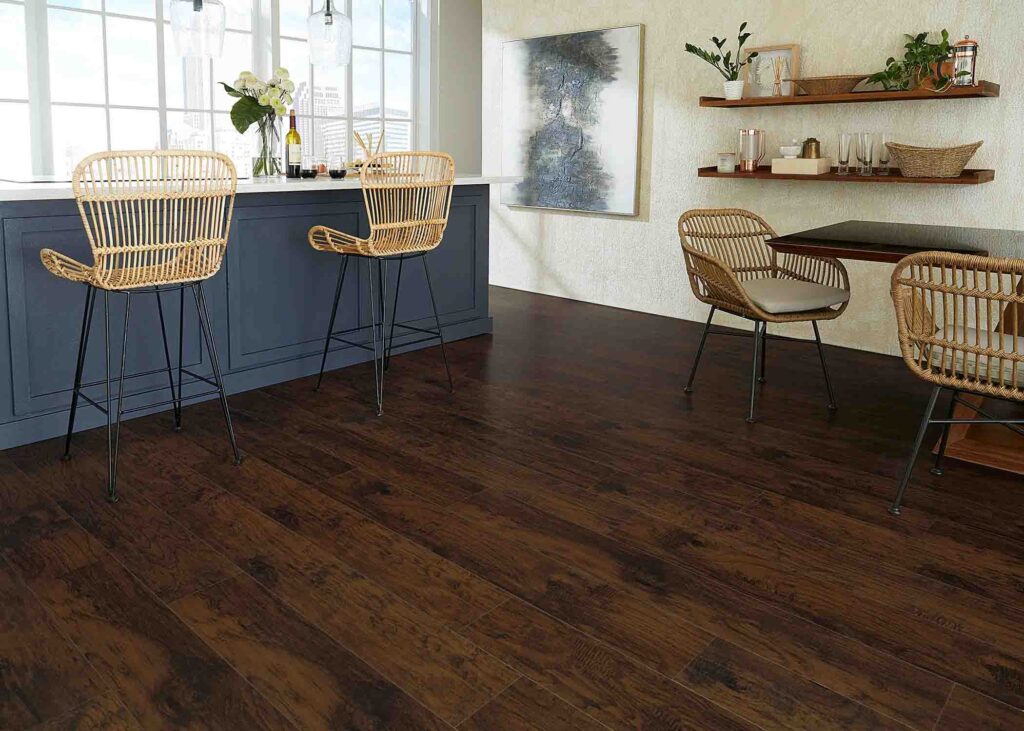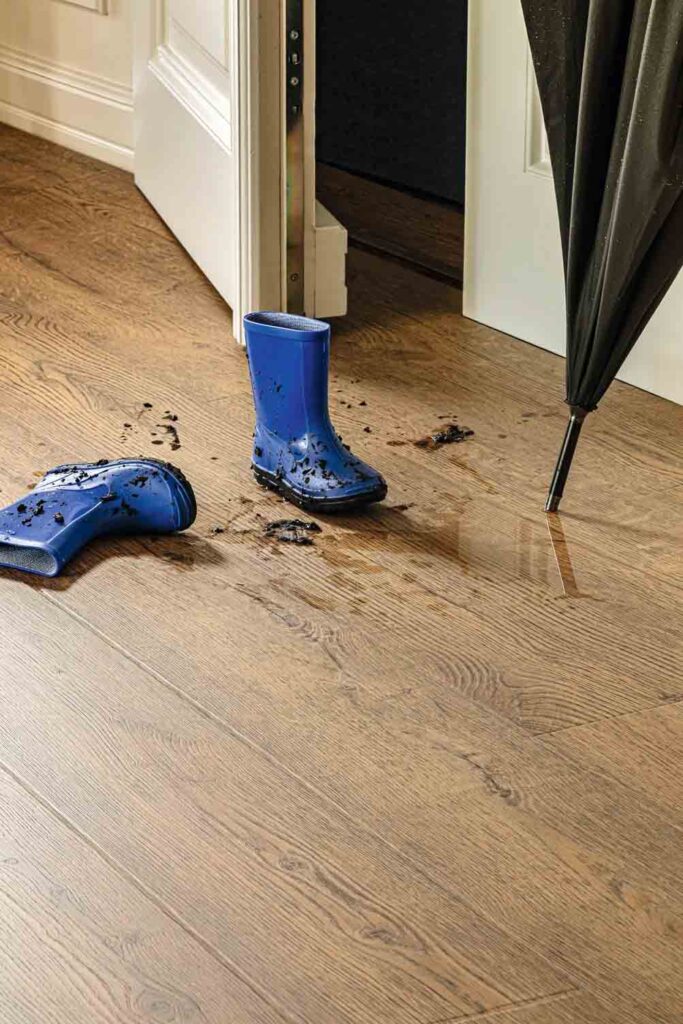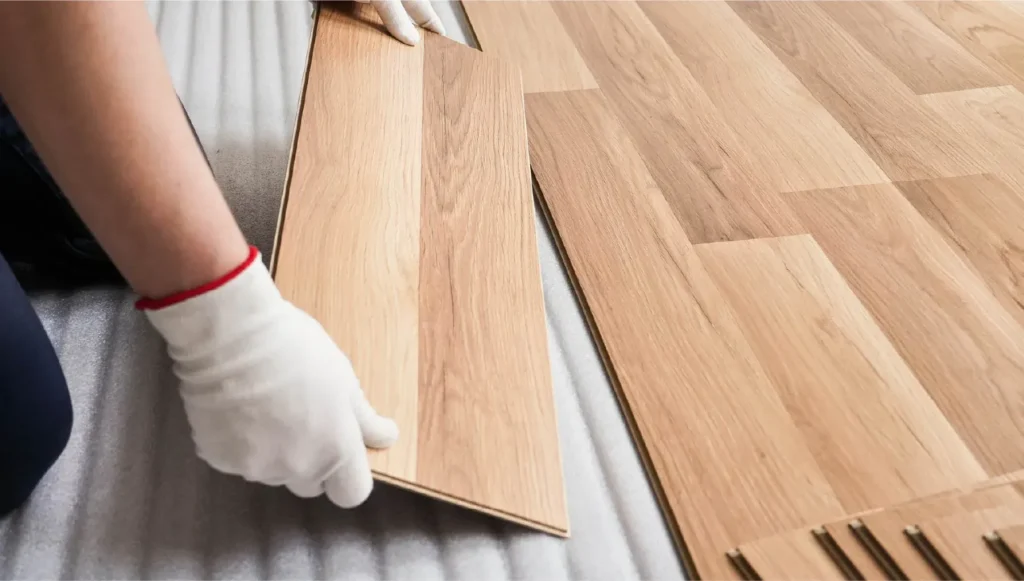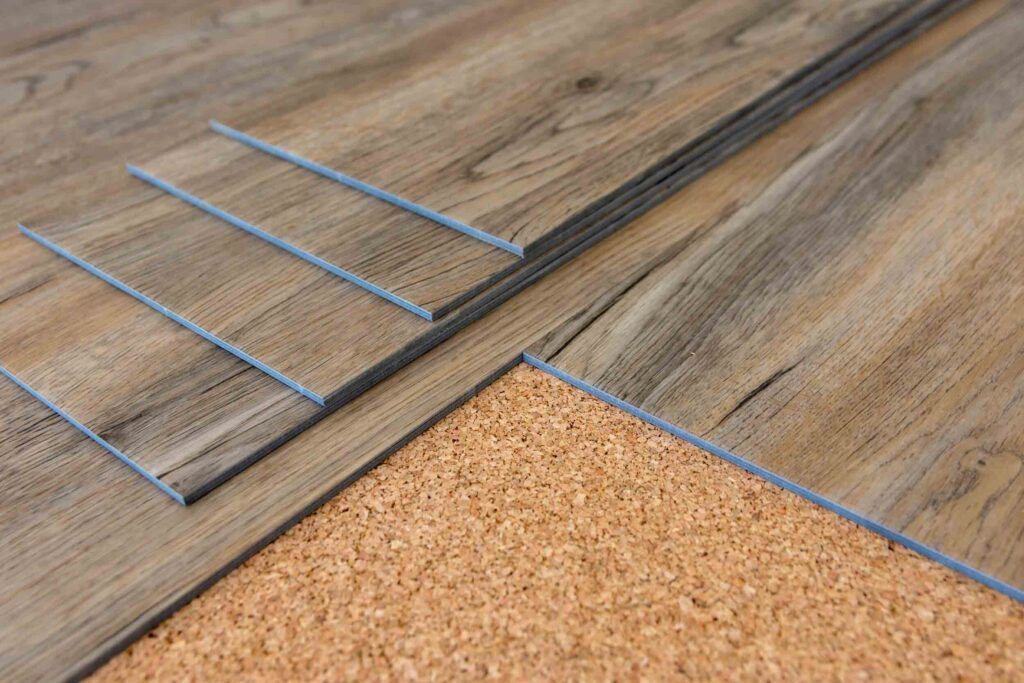Laminate flooring has become a top choice for homeowners and businesses looking to combine style, durability, and affordability. But one critical question often arises: Is laminate flooring truly waterproof? Many assume all laminate floors repel water, but the truth is more nuanced. Understanding which laminate floors offer genuine waterproof protection can save you costly repairs and frustration down the road.
Waterproof laminate flooring refers to specially engineered planks designed to resist water penetration both on the surface and through seams, unlike traditional laminate which only offers limited water resistance. These floors often feature advanced core materials and coatings that prevent swelling and warping when exposed to moisture.
Imagine installing a beautiful laminate floor in your kitchen, only to discover a spill or leak causes permanent damage in days. We’ve all heard stories like that — which is why knowing the real waterproof capabilities of laminate flooring is essential before you buy. Ready to dive into what makes laminate flooring waterproof, which products deliver on this promise, and whether it’s right for your space? Let’s get started.
1. What Does Waterproof Laminate Flooring Really Mean?

Waterproof laminate flooring means the product is engineered to prevent water from seeping into the core or seams, providing full protection against moisture damage—unlike traditional laminate that is only water-resistant.
What Waterproofing Really Involves
- Difference Between Waterproof and Water-Resistant Laminate Flooring Water-resistant laminate flooring can handle minor spills but is vulnerable to damage if water sits too long. Waterproof laminates are designed with special cores and coatings that block water absorption entirely.
- Testing Waterproof Performance Standards like AC (Abrasion Criteria) ratings and specialized water immersion tests assess how well laminate resists moisture. Some manufacturers also certify their floors with warranties against water damage.
- Materials and Technology That Enable Waterproofing Waterproof laminates often use high-density fiberboard (HDF) treated with water-repellent chemicals or alternative cores such as WPC (Wood Plastic Composite) or SPC (Stone Plastic Composite), which do not absorb water.
- Real-World Performance vs. Marketing Claims Some products labeled “waterproof” only resist water on the surface. True waterproof laminate prevents water from damaging joints or the core beneath, a crucial distinction for long-term durability.
Understanding these nuances will help you make smarter decisions, preventing expensive mistakes from choosing laminate flooring that can’t handle your home’s moisture levels.
| Aspect | Description |
|---|---|
| Difference Between Waterproof and Water-Resistant Laminate | Water-resistant handles minor spills; waterproof blocks water absorption entirely. |
| Testing Waterproof Performance | Uses AC ratings and water immersion tests; some floors come with water damage warranties. |
| Materials and Technology | Uses treated HDF, WPC, or SPC cores that do not absorb water. |
| Real-World Performance vs Marketing Claims | Some “waterproof” laminates only resist surface water; true waterproof protects core and joints. |
2. Which Types or Brands of Laminate Flooring Are Truly Waterproof?

True waterproof laminate flooring typically uses WPC or SPC cores and is offered by brands like Pergo, Mohawk, and Armstrong, known for combining durability with water resistance technology.
Identifying Reliable Waterproof Laminate Options
- Material Cores That Deliver Waterproofing
- WPC (Wood Plastic Composite): Combines wood fibers and plastic, highly water-resistant with some flexibility.
- SPC (Stone Plastic Composite): Denser, rigid core made of limestone and plastic, offering superior waterproofing and durability.
- Top Brands Known for Waterproof Laminate Brands such as Pergo’s “Outlast+” collection, Mohawk’s “SolidTech,” and Armstrong’s “Vantage” lines have proprietary waterproof cores and locking systems designed to repel water.
- Price vs. Performance Tradeoffs Waterproof laminates tend to be priced higher due to advanced materials and manufacturing. Cheaper laminates labeled “water-resistant” may not offer lasting protection.
- Installation Methods Impact on Waterproofing Even the best waterproof laminate can fail if seams are poorly installed or if the floor lacks proper underlayment and moisture barriers.
- Warranty and Customer Reviews Check for comprehensive warranties covering water damage, and read reviews to learn how products perform in real-life scenarios like kitchens, bathrooms, or basements.
By comparing these aspects, you can narrow down waterproof laminate options that truly live up to their promises.
| Factor | Details |
|---|---|
| Material Cores | WPC: wood fibers + plastic, water-resistant and flexible; SPC: limestone + plastic, dense and durable |
| Top Brands | Pergo (“Outlast+”), Mohawk (“SolidTech”), Armstrong (“Vantage”) with proprietary waterproof cores |
| Price vs. Performance | Waterproof laminates cost more; cheaper “water-resistant” options may lack lasting protection |
| Installation Importance | Proper seam installation and moisture barriers critical to maintain waterproof performance |
| Warranty & Customer Feedback | Look for water damage warranties and real-life user reviews for performance insights |
3. How Does Waterproof Laminate Flooring Compare to Other Flooring Types?

Waterproof laminate flooring offers a balance between cost, appearance, and moisture protection, but vinyl, SPC flooring, and engineered hardwood each have distinct advantages and drawbacks in wet environments.
Comparing Waterproof Laminate with Alternatives
- Vinyl Flooring: 100% waterproof and often more flexible, vinyl handles moisture better but can feel less natural compared to laminate’s realistic wood textures.
- SPC Flooring: Often categorized separately but closely related to laminate, SPC flooring features an ultra-dense, fully waterproof core and higher impact resistance, ideal for commercial and high-moisture areas.
- Engineered Hardwood: Offers authentic wood aesthetics with some moisture resistance but can still swell or warp if water penetrates.
- Cost Considerations: Vinyl and SPC generally cost more upfront than standard laminate but offer longer warranties and better waterproof guarantees.
- Installation Differences: Vinyl can be glued down or floated; SPC is typically click-lock floating; laminate varies by type but all require careful sealing at edges.
- Aesthetic and Comfort: Laminate often provides superior scratch resistance and warmer feel underfoot compared to vinyl, making it a popular mid-range option.
Understanding these trade-offs helps decide which flooring suits your lifestyle, budget, and moisture exposure best.
| Flooring Type | Waterproof Performance | Cost Range | Installation Method | Aesthetic & Comfort | Ideal Use Cases |
|---|---|---|---|---|---|
| Waterproof Laminate | Good balance of water resistance and design | Mid-range | Click-lock floating; requires sealing | Realistic wood look, warmer feel, scratch-resistant | Residential kitchens, living areas |
| Vinyl Flooring | 100% waterproof, very flexible | Higher than laminate | Glue down or float | Less natural texture, highly durable | Bathrooms, wet areas, commercial spaces |
| SPC Flooring | Ultra-dense, fully waterproof core | Higher upfront | Click-lock floating | Durable, rigid, commercial-grade finish | High moisture, heavy-traffic commercial areas |
| Engineered Hardwood | Some moisture resistance, can warp | High | Nail down, glue down, float | Authentic wood aesthetics | Low-moisture residential spaces |
4. Do Waterproof Laminate Floors Require Special Installation or Maintenance?

Waterproof laminate flooring usually requires precise installation with moisture barriers, and regular cleaning with non-abrasive methods to preserve its waterproof integrity and appearance.
Installation and Care Best Practices
- Underlayment and Moisture Barriers Using vapor barriers and specialized underlayments can prevent moisture rising from subfloors, critical in basements or concrete slabs.
- Sealing Edges and Transitions Applying sealants or water-resistant trims around edges helps keep water from seeping into seams or under the floor.
- Cleaning Recommendations Avoid excessive water or harsh chemicals; use damp mops and cleaners formulated for laminate to prevent damage.
- Repair and Replacement Waterproof laminates generally resist warping, but damaged planks should be replaced promptly to maintain protection.
- DIY vs. Professional Installation Even though waterproof laminates often feature click-lock systems, professional installers can ensure tight seams and proper subfloor prep for long-term success.
Proper installation and maintenance directly affect how well your waterproof laminate floor performs and lasts.
| Aspect | Best Practices |
|---|---|
| Underlayment & Moisture Barriers | Use vapor barriers and specialized underlayments to prevent moisture from subfloors |
| Sealing Edges & Transitions | Apply sealants or water-resistant trims to protect seams and edges |
| Cleaning Recommendations | Use damp mops and laminate-safe cleaners; avoid excessive water and harsh chemicals |
| Repair & Replacement | Replace damaged planks promptly to maintain waterproof integrity |
| DIY vs Professional Installation | Professional installation ensures tight seams and proper subfloor prep for durability |
5. Is Waterproof Laminate Flooring Suitable for All Rooms and Environments?

Waterproof laminate flooring is ideal for kitchens, entryways, and basements, but caution is advised for full bathrooms or areas with standing water where other flooring may be preferable.
Room-by-Room Suitability Analysis
- Kitchens and Dining Areas High foot traffic and frequent spills make waterproof laminate an excellent choice here.
- Bathrooms While waterproof laminate can handle humidity and splashes, standing water can still cause damage over time; tile or vinyl may be better for wet zones.
- Basements and Laundry Rooms Proper moisture barriers allow waterproof laminate to thrive in these spaces prone to dampness.
- Commercial Spaces Durable waterproof laminates can stand heavy use but must meet commercial-grade standards for abrasion and wear.
- Outdoor Use Not recommended; despite waterproof claims, laminate is not designed for outdoor exposure or UV damage.
Evaluating room conditions and expected moisture levels ensures you select flooring that performs well and lasts.
| Room/Environment | Suitability for Waterproof Laminate Flooring | Notes |
|---|---|---|
| Kitchens & Dining | Highly suitable; handles spills and foot traffic well | Ideal for busy family areas |
| Bathrooms | Caution advised; good for humidity and splashes but not standing water | Tile or vinyl preferred in wet zones |
| Basements & Laundry | Suitable with proper moisture barriers | Protects against dampness when installed correctly |
| Commercial Spaces | Suitable if flooring meets commercial abrasion and wear standards | Must choose durable, high-grade waterproof laminate |
| Outdoor Use | Not recommended | Susceptible to UV damage and weather exposure |
6. Are Waterproof Laminate Flooring Products Environmentally Friendly and Durable?

Many waterproof laminate floors now incorporate eco-friendly materials and manufacturing, while offering durable surfaces resistant to scratches, dents, and wear under normal and commercial traffic.
Sustainability and Durability Factors
- Sustainable Materials and Certifications Some waterproof laminates use recycled wood fibers, low-VOC adhesives, and comply with environmental certifications like FloorScore or GREENGUARD.
- Durability Testing Laminate floors undergo AC ratings (from AC1 to AC5) indicating resistance to abrasion and wear, with waterproof variants typically rated AC3 or higher for residential use.
- Lifespan and Warranty Waterproof laminate flooring can last 15-25 years when properly maintained, backed by manufacturer warranties against water damage and wear.
- Recyclability and Disposal While recycling options are limited, some brands offer take-back programs or use materials that minimize environmental impact.
- Balancing Performance and Eco-Impact Advances in composite materials provide waterproofing without heavy chemical use, balancing durability with sustainability goals.
Choosing waterproof laminate flooring that meets your environmental values and durability needs is possible with careful research.
| Factor | Details |
|---|---|
| Sustainable Materials & Certifications | Use of recycled wood fibers, low-VOC adhesives, certified by FloorScore, GREENGUARD |
| Durability Testing | AC ratings (AC1-AC5) measure abrasion resistance; waterproof laminates usually rated AC3+ |
| Lifespan & Warranty | Typically lasts 15-25 years; warranties cover water damage and wear |
| Recyclability & Disposal | Limited recycling options; some brands offer take-back programs or eco-friendly materials |
| Performance vs Eco-Impact | New composites provide waterproofing with reduced chemical use, balancing durability and sustainability |
Ready to Upgrade Your Flooring?
At Kinwin, we specialize in custom waterproof SPC and laminate flooring solutions tailored to your exact needs. Whether you’re outfitting a residential kitchen or a commercial space with high moisture exposure, our innovative designs and strict quality control ensure you get durable, eco-friendly floors that last.
Contact Kinwin today to request a quote and explore personalized flooring options that combine style, performance, and sustainability. Let’s build your perfect waterproof flooring solution together.


